European Travels 12 – Bordeaux and Arcachon
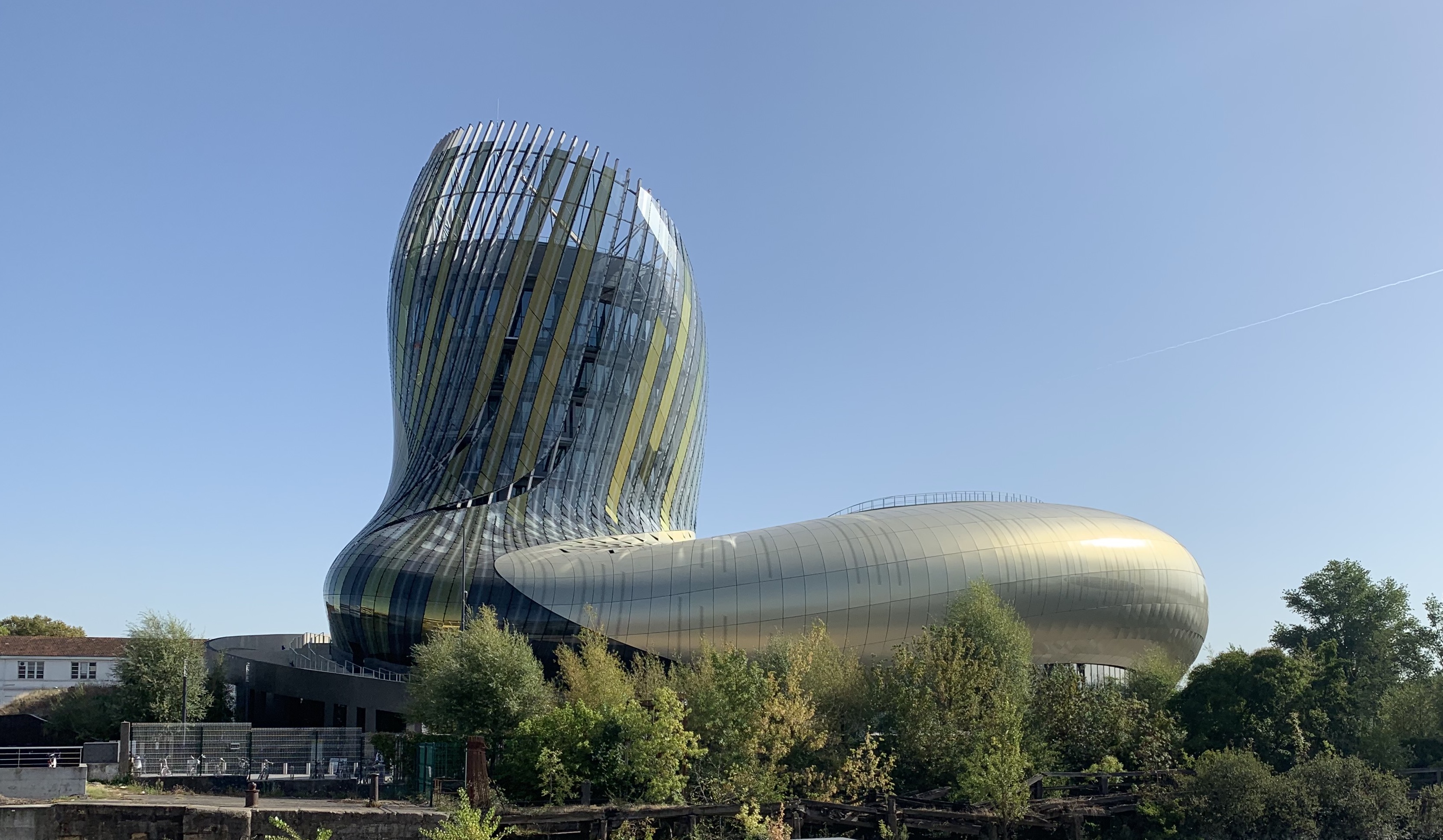 (Updated May 29, 2022)
(Updated May 29, 2022)
With international travels taking off again, a visit to Bordeaux and Arcachon (France) could be also on your itinerary this year.
In September 2019, as we flew from Amsterdam to Bordeaux, Ulrike and I had no idea yet how different our life would be in a few months. I am writing this post just about a year after our trip.
Checking the websites of the places which we visited during our week-long stay in Bordeaux and travels through the Périgord region, I realize that many activities are out of reach at the moment: exploring Bordeaux by tram and bus, visiting museums, a wine tasting class in the Cité du Vin (see picture above), a river cruise with Bruno, visiting castles and the Lascaux caves, wine tasting in vineyards, etc, etc.
Fortunately, the memories and pictures from that trip will last us for a while. And maybe this post will motivate some readers to explore Bordeaux and its surroundings once the Covid-19 period has passed!
A Very Brief History of Bordeaux
As we usually do in a new city, we visited the local history museum, here the Musée d'Aquitaine. This gave us a quick and comprehensive overview of both Bordeaux's ancient and recent history.
We learned that Bordeaux's importance as a major port increased after the marriage in 1152 of Eleanor of Aquitaine with Henry Plantagenet (who is better known as Henry II and was King of England from 1152-1189).
The “English era” gave Bordeaux protection, and the wine trade and tax-free status with England made the city flourish right into the middle of the 15th century.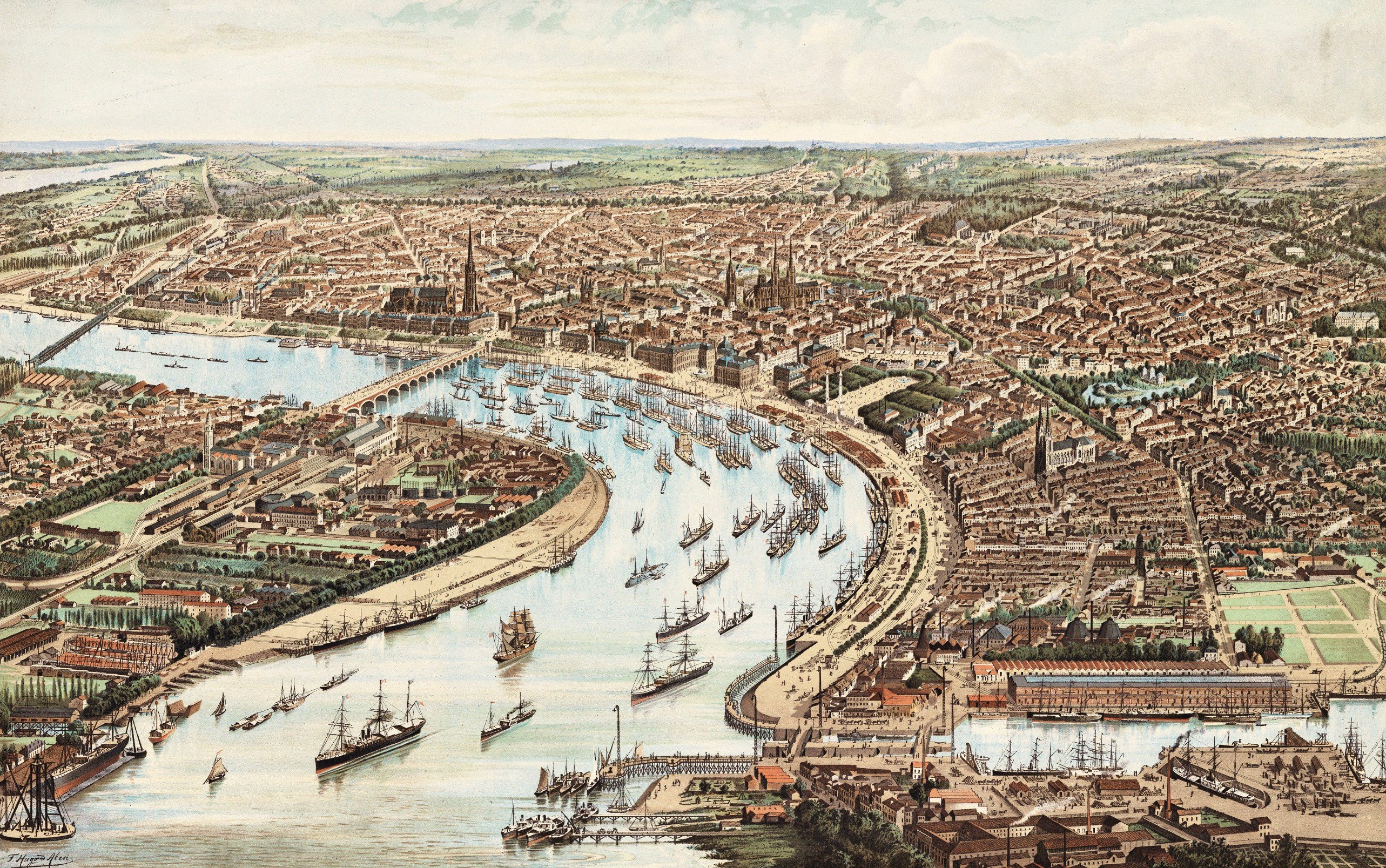
Annexed by France in 1453, Bordeaux eventually entered into another golden era in the 18th century, when it became France's busiest port, supplying much of Europe with coffee, sugar, cotton, etc from overseas. (Image by Hugo d'Alesi, 1899, Archives de Bordeaux métropole.)
After World War II, two long-serving mayors were responsible for Bordeaux's development: Jacques Chaban-Delmas from 1947-1995 and Alain Juppé from 1995-2019, both with various interruptions, as they also served as Prime Ministers under Jacques Chirac and Georges Pompidou respectively.
Today the Bordeaux metropolitan area has a population of about 780,000 with about 250,000 living in the city. As such, it is France's sixth largest city, the capital of the Nouvelle-Aquitaine region and the center of a major wine-growing and wine-producing region.
Exploring Bordeaux by Tram
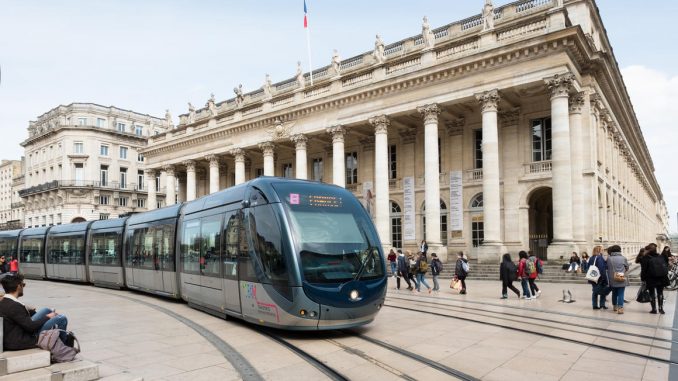 Neither Ulrike nor I had ever been in Bordeaux or that part of France before. We especially looked forward to exploring the surrounding wine country as well.
Neither Ulrike nor I had ever been in Bordeaux or that part of France before. We especially looked forward to exploring the surrounding wine country as well.
Our rental apartment was near the Place Gambetta, right in the center of town. This allowed us to explore “la vieille ville” and other quarters on foot, and by using several tram lines that were nearby.
Eager to use the public transport system, trams and buses, we made the mistake of purchasing a seven-day transport card online. Why a mistake? Because each time we used a tram, we had to use our smartphone and internet connection to validate. (A better choice is to purchase a 7-day card in one of the public transport offices.)
And as the tram was our favorite mode of transport, we noticed one thing right away: there were no overhead wires in the city. We were intrigued. (See picture above of tram in front of the Bordeaux Opera.) I noticed that there was a center rail set in the pavement, but people normally walked over it, so obviously it could not be electrified.
A Google search and our visit to the Historical Museum solved the mystery: Mayor Chaban-Delmas had the last of the 38 tramlines, with their over 120 miles of tracks, removed in 1958. But plans for a subway failed because of the sandy soil and related costs.
The “Bordelaises and Bordelais” (women and men of Bordeaux) had to wait until 2003, 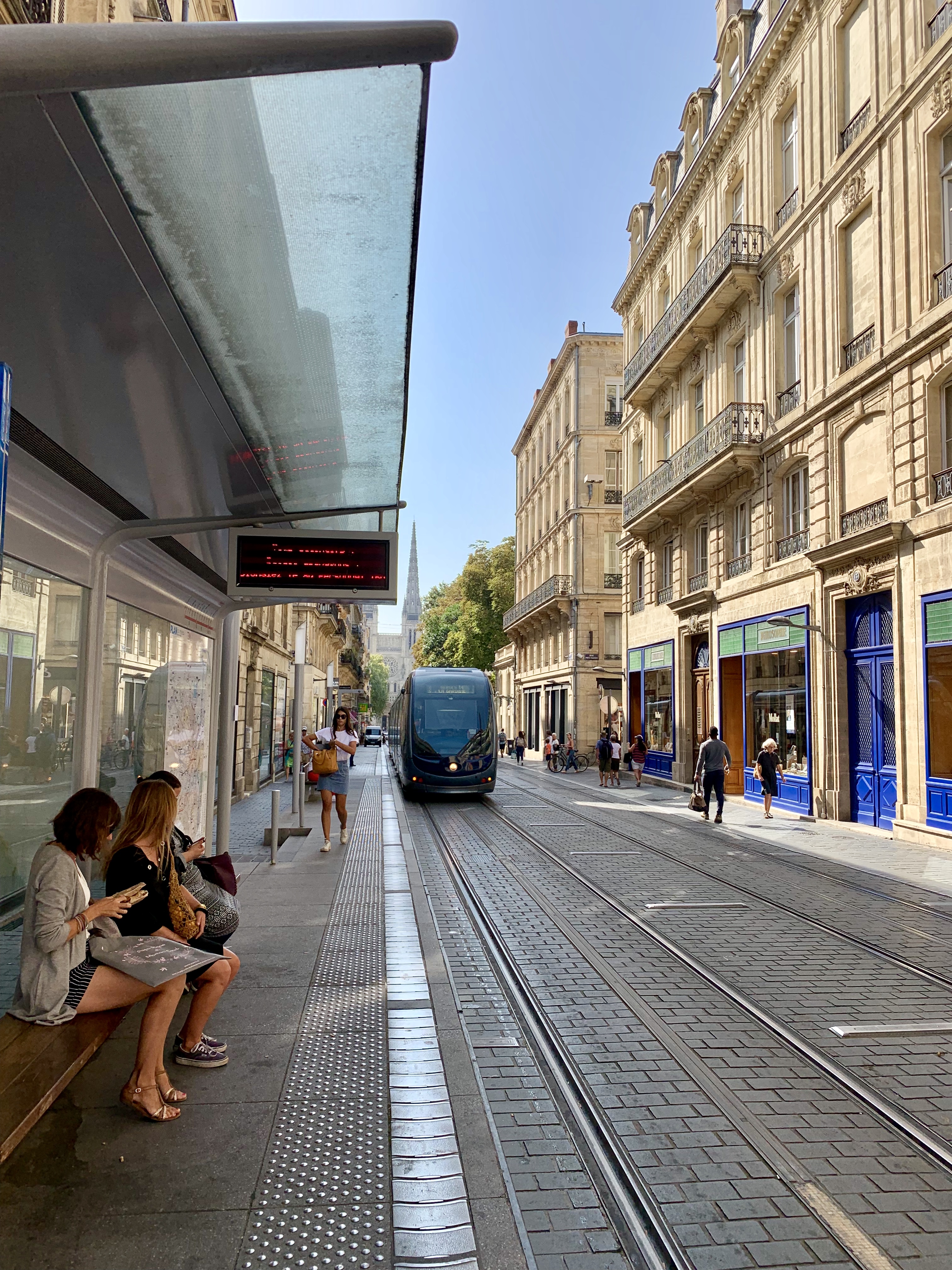 when the first of the now 3 lines (about 40 miles) of a modern tramway were opened. Mayor Alain Juppé had insisted that no overhead wires should spoil the view of the buildings in the city.
when the first of the now 3 lines (about 40 miles) of a modern tramway were opened. Mayor Alain Juppé had insisted that no overhead wires should spoil the view of the buildings in the city.
Thus a ground-level power supply operates in the city, called APS (Alimenation Par Sol). The center rail is not continuous, but connected with what look like ceramic isolators. (You can see the center rail with the light brown isolator in the picture.)
In the city, electric power is supplied to the tram by the center rail with only the portion under the tram electrically live. Reportedly, the system had problems at the start, but seemed to work well while we were there. (We wonder, however, how it would work during snow and ice conditions.)
Once the tram leaves the inner city, the overhead lines appear again and each tram raises its collector arm (pantograph) to connect.
Cité du Vin
One of the must-see sites when you visit Bordeaux is Cité du Vin, the Bordeaux Wine Museum. You can get there either by tram or by water shuttle on the Garonne river.
At the museum, you will learn more about the world's wine cultures than you'll likely remember. The permanent exhibition explains how “humans cultivate vines all over the world in a wide variety of natural conditions. Winegrowers have adapted, invented and modeled their landscapes and shaped them through their traditions.”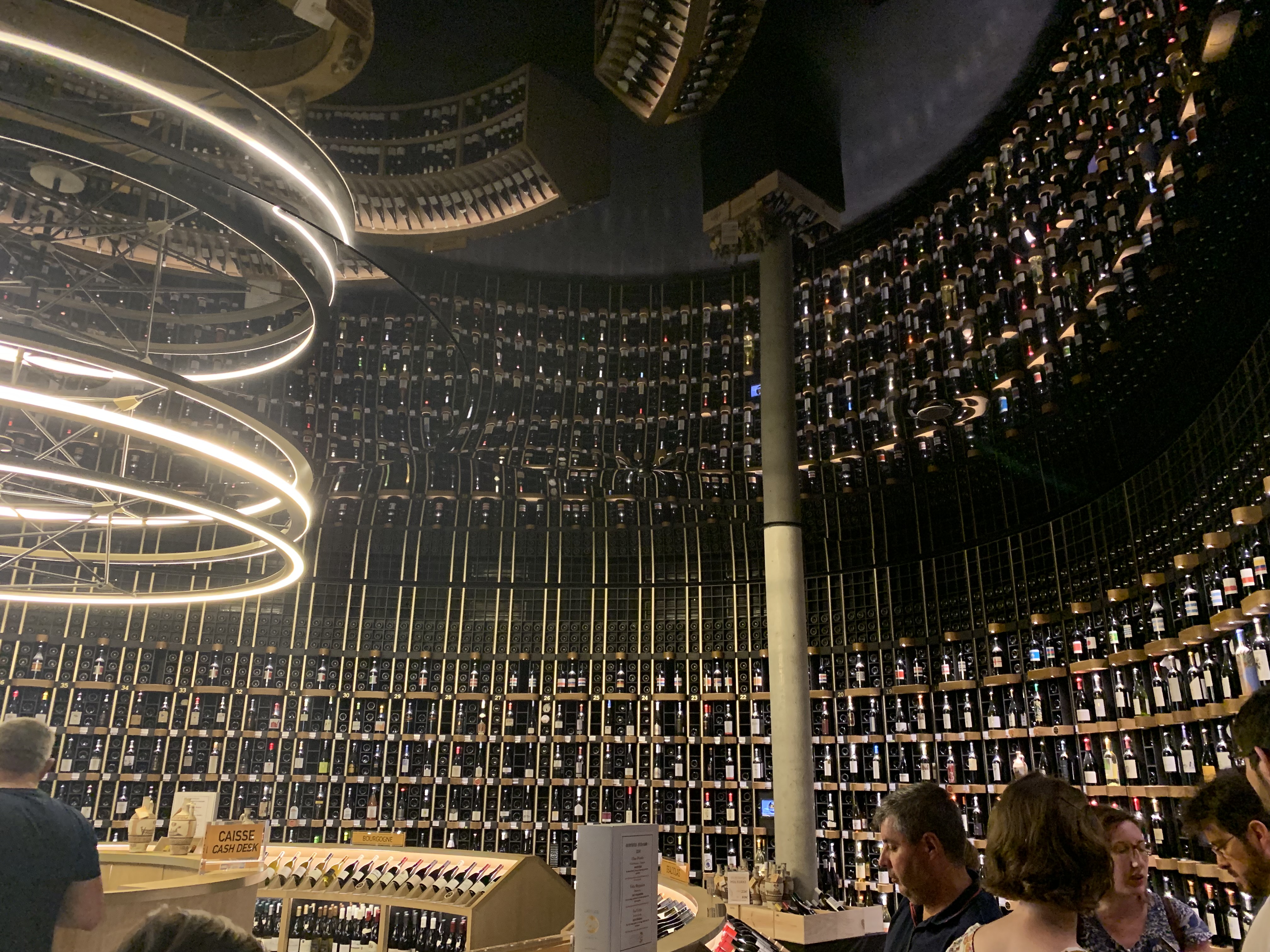 We also decided to take a wine tasting class in French. The teacher was entertaining and familiarized an international audience with the basics of French wine terminology.
We also decided to take a wine tasting class in French. The teacher was entertaining and familiarized an international audience with the basics of French wine terminology.
And while it certainly takes more than a one-hour class to become a real wine connoisseur, we became fully aware of how many vivid adjectives the French language has for describing wines.
For example: The level of “acidité” (acidity) can be described by words like “mou, vif, nerveux” (soft, lively, nervous); the level of “tanin” (tannin) with “souple, charpenté, âpre” (flexible, framed, harsh); the level of “onctuosité” (smoothness) with “creux, gras, lourd” (hollow, fat, heavy).
And most importantly, we learned: When you “name” (i.e. pin down with words) your own impression of the wine that you're sampling, you'll better remember a similar taste next time. (But it requires that you equip yourself with the relevant vocabulary to describe your impressions! Here is a link to such a wine glossary in English.)
The shop at Cité du Vin has a large selection of wines from the region (see picture above), and from the top of the spectacular building (where more wine tasting occurs), you have a spectacular view of Bordeaux and the Garonne river.
We recently came across an interesting article about The History of Wine. The article describes many of the historic facts that you'll learn about in the Cité du Vin's informative and interactive exhibitions.
Bordeaux's Museums
Besides the Musée d’Aquitaine and la Cité du Vin, we also enjoyed the MECA,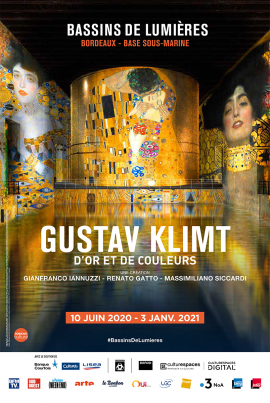 musée des arts décoratifs et du design, and the Musée Mer Marine (Maritime Museum).
musée des arts décoratifs et du design, and the Musée Mer Marine (Maritime Museum).
Indeed, when we visited the Maritime Museum, we were also intrigued by the nearby submarine bunkers. An unattractive remnant of World War II, which had housed the Italian submarine fleet at the time, its thick concrete walls and roof have made demolition cost-prohibitive.
At the time of our visit, parts of this base were just being converted into the Bassins de Lumières. While not yet open to the public then, the above link and picture give you an impression of a spectacular exhibit, which appears well worth visiting.
La Garonne and Le Miroir d'Eau
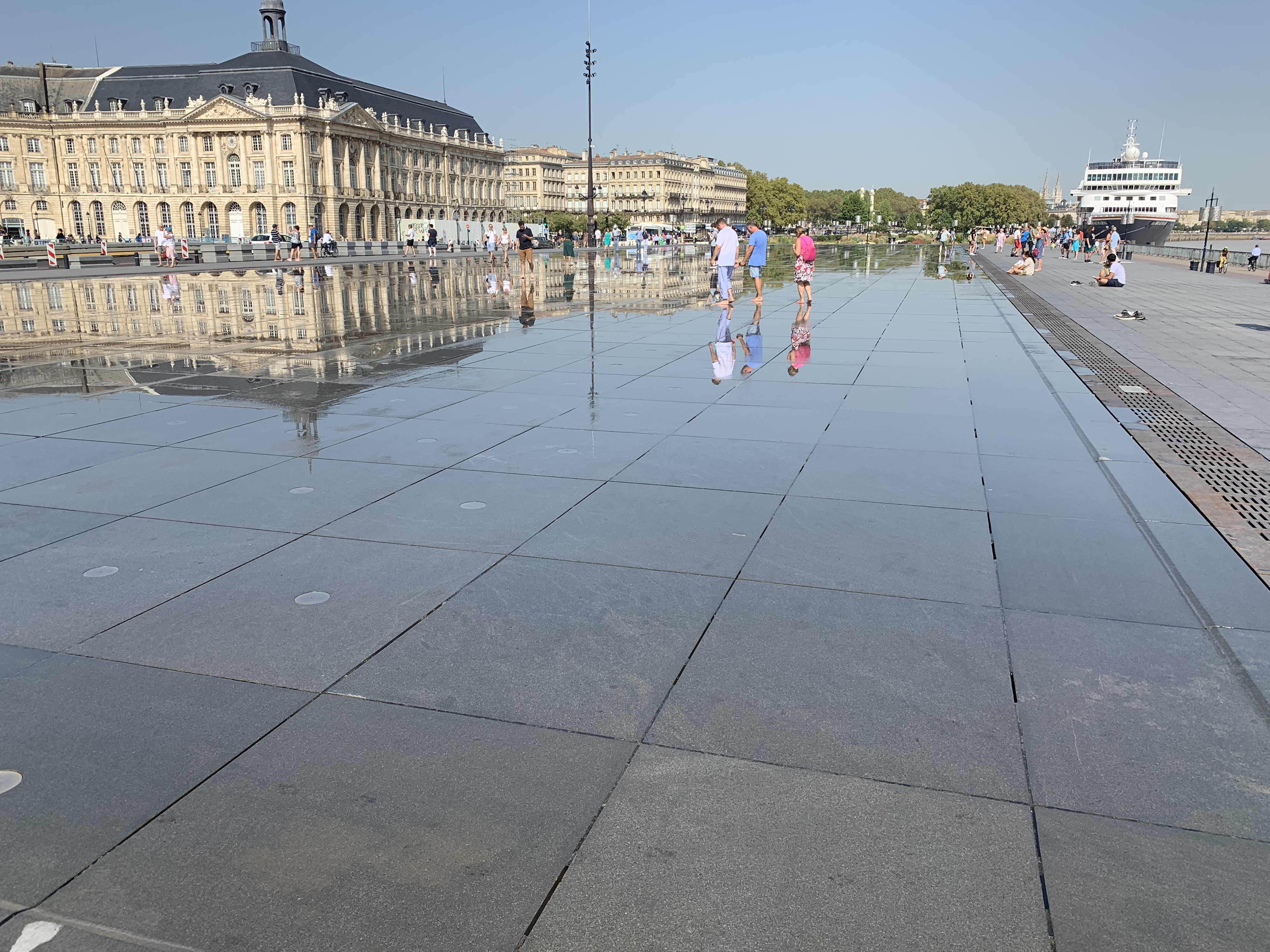 For many cities a waterway adds to their special appeal and Bordeaux is no exception (see also Lisbon, Portugal).
For many cities a waterway adds to their special appeal and Bordeaux is no exception (see also Lisbon, Portugal).
Pictures in the Musée d'Aquitaine showed us that before World War II and even into the 1960s, the Garonne river's waterfront had been a busy port, with ocean-going ships docking right up to the Pont de Pierre.
Today commercial harbor terminals and pontoons, especially for container ships, have moved downstream. But major cruise ships can still dock downtown, close to the Place de la Bourse and the Miroir d'Eau.
There is now a wonderful promenade that stretches from beyond the 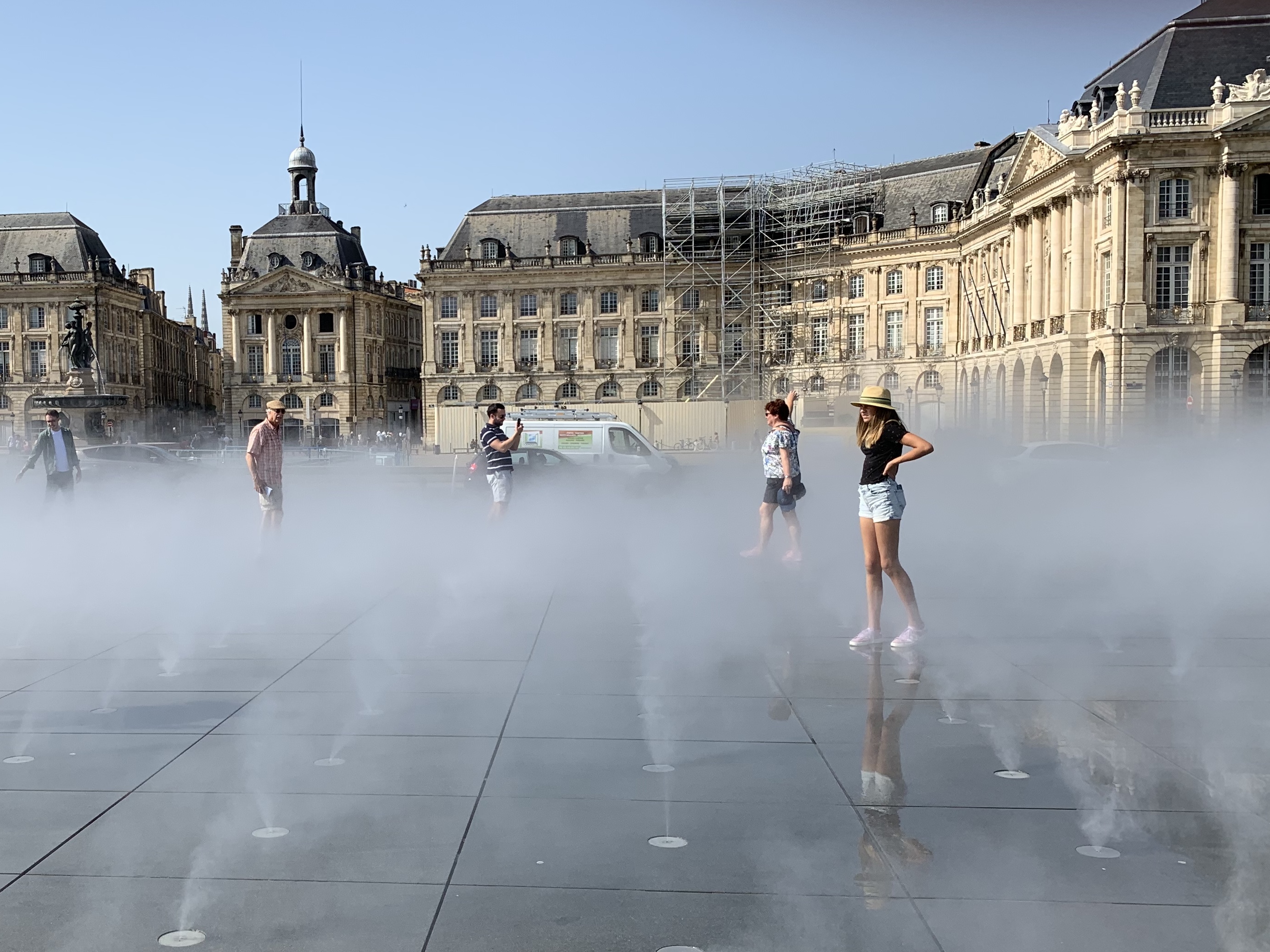 Pont de Pierre to the row of converted warehouses downstream. These hangars house various expositions and events as well as brand-name discount shops.
Pont de Pierre to the row of converted warehouses downstream. These hangars house various expositions and events as well as brand-name discount shops.
The Miroir d'Eau, in front of the Place de la Bourse is reportedly the world's largest reflecting pool with 37,100 sqft. It is indeed quite spectacular, both as a mirror and also when the rising mist begins to hide the people walking around.
I would be amiss if I didn't comment on the color of the Garonne river.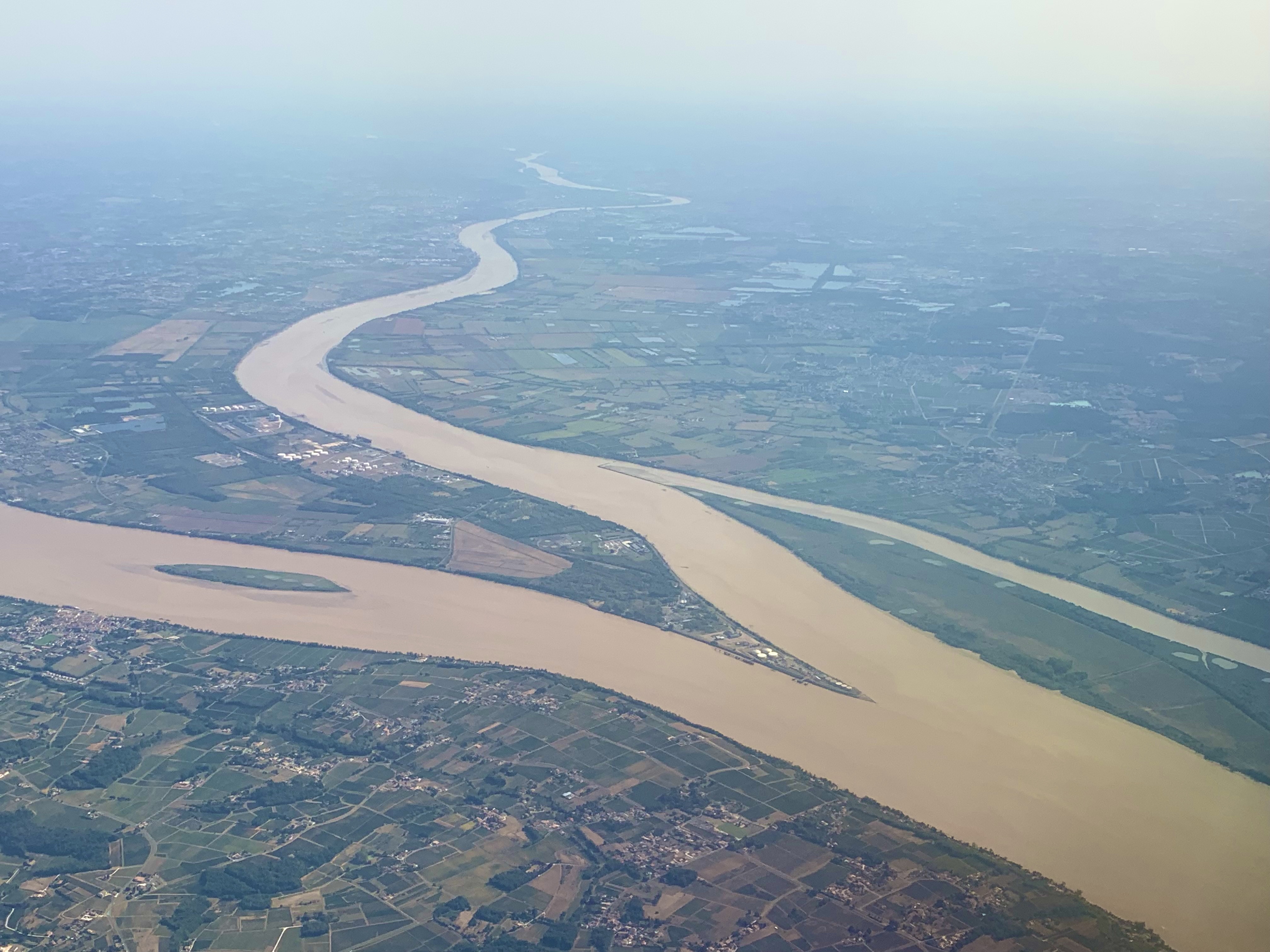 I had already noticed the brown color of both the Garonne and the Dordogne rivers from the plane as it made its approach to the Bordeaux airport.
I had already noticed the brown color of both the Garonne and the Dordogne rivers from the plane as it made its approach to the Bordeaux airport.
Bruno, our Garonne river cruise guide, made it his first point of business to explain why the Garonne is NOT “dirty”: the color is the end-result of a natural phenomenon.
The sediment that the Garonne carries downstream meets the oceanic tides that come up the estuary. With salty water being heavier than fresh water, the undercurrent brings the sediment to the surface and coagulates in the form of microscopic flakes, producing the brown color. Nevertheless the Garonne is ranked as one of Europe's cleanest rivers!
Arcachon and the Dune du Pilat
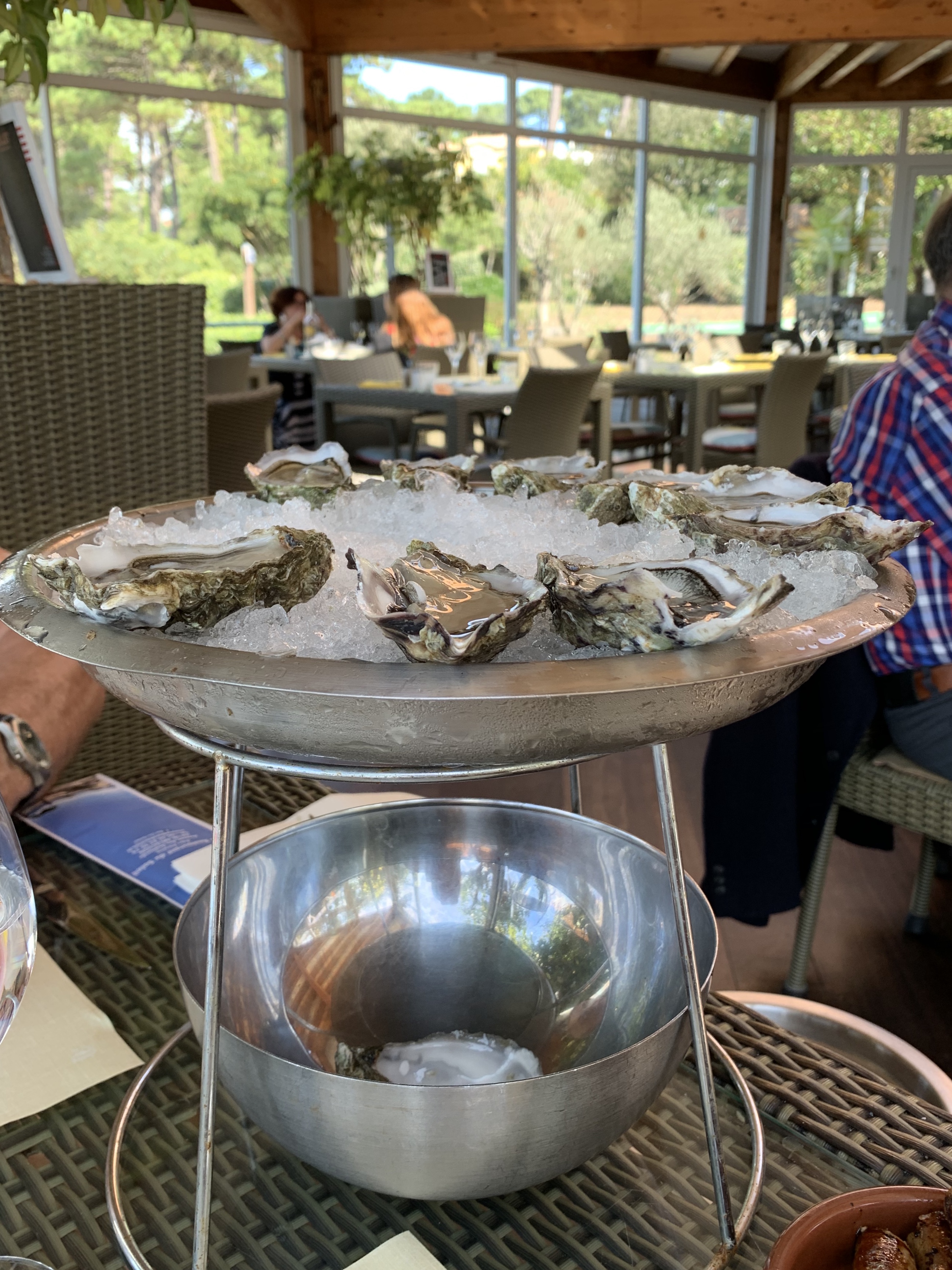 At the end of our one-week stay in Bordeaux we rented a car to explore the surrounding wine country. (More about that in another post.)
At the end of our one-week stay in Bordeaux we rented a car to explore the surrounding wine country. (More about that in another post.)
We had heard from friends that a visit to Arachon was also a must: both for its famous oysters as well as for the “Dune of Pilat”. Arcachon is only a 40 mile drive from Bordeaux and a favorite weekend spot for many locals.
For centuries the name of Arcachon has been related to “great oysters”, and keeping the Arcachon Bay unpolluted is of key concern for many area residents.
(Over the last 50 years there have been a number of natural and man-caused disasters affecting the oysters in the bay.) The area's oyster industry grows oysters for the French restaurant market as well as seed oysters for oyster growers all over Europe.
The delightful little Hôtel du Parc, where we stayed, was in walking distance to the Plage Pereire. After renting bicycles directly at the hotel, we were soon using the bike paths up and down along the beach.
We even made it all the way to downtown Arcachon and its harbor. The downtown area is not very attractive, as it is overbuilt with hotels and condominiums.
However, the promenade along Arcachon Bay with its beach, promenade, restaurants and large marina is lovely. It was still bustling during the weekend even at the end of September. Sitting in one of the many restaurants, "people watching" can be a great pastime!
We sampled the famous “huitres” (oysters) at several restaurants. Our favorite was the Restaurant du Soleil, right at the beach, with a fabulous view of the sun set each evening.
Climbing up the Dune du Pilat was an amazing experience. Located just south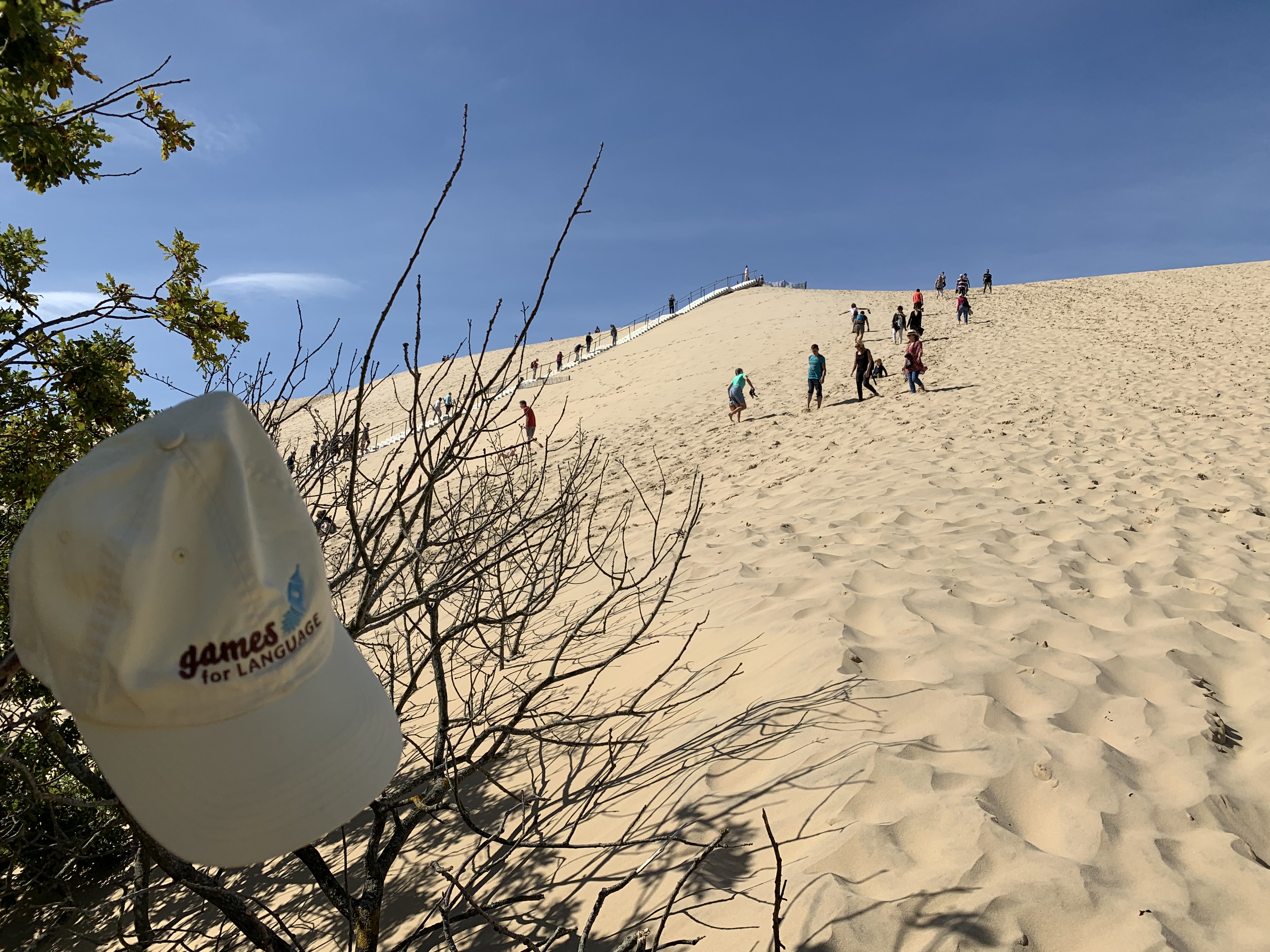 of the entrance to the Bay of Arcachon, the dune rises to over 300 feet above sea level and is about 1.7 miles long.
of the entrance to the Bay of Arcachon, the dune rises to over 300 feet above sea level and is about 1.7 miles long.
The name “Pilat” (or “Pyla”, to the locals) originates from the Gascon word “philar”, which means heap or mound.
On the last September weekend there was a stream of visitors climbing up and down the dunes, some picnicking on top, others just watching the para gliders making their turns and – because of the upwinds – often landing above from where they started.
The dune has been observed to move backwards at the rate of about 15 feet per year, encroaching on the pine forest and swallowing up houses built at its base. This explains why the visitor center and large parking lot have been placed far in the back.
After our stay in Arcachon we still had a few days left to explore the “Médoc region” to the left of the Gironde estuary, but we'll report on that in our next post.
Bio: Peter Rettig is the co-founder of Gamesforlanguage.com. He's a lifelong language learner, growing up in Austria, Germany, and Switzerland. You can follow him on Facebook, Twitter and Instagram, and leave any comments with contact.
